Shear Behavior of Steel-Fiber-Reinforced Recycled Aggregate Concrete Deep Beams
Abstract
:1. Introduction
2. Research Objectives
- Investigate the effect of using a 100% RCA on the shear behavior of concrete deep beams with and without traditional shear reinforcement.
- Examine the effectiveness of using steel fibers at different volume fractions to improve the shear behavior of RCA-based concrete deep beams.
- Investigate the potential use of steel fibers as a substitution to traditional shear reinforcement in RCA-based concrete deep beams.
- Examine the accuracy and validity of published analytical models to predict the shear capacity of the tested beams.
3. Experimental Program
3.1. Materials
3.2. Mixture Proportioning
3.3. Specimens Preparation
3.4. Properties of Concrete Mixtures
3.5. Deep Beam Test Specimens
3.6. Test Setup
4. Experimental Results and Discussion
4.1. Deflection Response
4.2. Shear Cracking Load and Shear Capacity
4.3. Crack Pattern and Failure Mode
4.4. Sirrup Strains
4.5. Tensile Steel Strains
4.6. Concrete Strains
5. Analytical Procedure
6. Conclusions
- Concrete deep beam specimens with a 100% RCA without steel fibers exhibited a lower stiffness, reduced shear cracking load, lower shear capacity, and higher midspan deflections than those of their NA-based counterparts. This is a new finding since no information is available in the literature on the shear behavior of RCA-based concrete deep beams. Nevertheless, this conclusion is in line with data published in the literature for slender beams [5,6,7,8,9], indicating the inferior structural shear performance for RCA-based concrete slender beams.
- The impact of using a 100% RCA rather than NAs on the shear response was less significant in the presence of traditional shear reinforcement. The shear cracking load and shear capacity were reduced by 25 and 5% in the absence of traditional shear reinforcement due to the full replacement of NA by RCA. Nevertheless, only 12 and 2% reductions in the shear cracking load and shear capacity, respectively, were recorded in the presence of traditional shear reinforcement. The negligible shear strength reduction observed in the present study for RCA-based beams with internal shear reinforcement is consistent with that reported in the literature for beams with internal steel stirrups with a/h of 2.5 [28].
- The inclusion of steel fibers in RCA-based deep beam specimens significantly improved their post-cracking stiffness. The stiffness of the RCA-based specimens with vf of 1 and 2% coincided with that of their RCA-based counterpart with traditional shear reinforcement. The inclusion of steel fibers at vf of 3% further improved the beam stiffness to a level even higher than that of its counterpart with traditional shear reinforcement. The improvement in the post-cracking stiffness of RCA-based beams due to the addition of steel fibers is a new finding, despite being consistent with other findings published in the literature for NA-based concrete deep beams [23,24,25,26,27].
- The inclusion of steel fibers in the RCA-based beams resulted in a remarkable increase in their shear cracking load to a level even higher than that of the control NA-based containing traditional shear reinforcement. The addition of steel fibers also improved the shear capacity of the RCA-based beams. The RCA-based beams with vf of 1, 2, and 3% exhibited respective shear capacity gains of 22, 40, and 107%, relative to that of the control RCA-based counterpart without fibers. The feasibility and effectiveness of using steel fibers at volume fractions of up to 3% to improve the shear response of RCA-based deep beams demonstrated in the present study are new findings that have not been reported previously in the literature. Nevertheless, the improved shear capacity of the RCA-beams with fibers is in line with findings of a single study conducted previously on the shear behavior of RCA-based beams with a/h of 2.5, where a 56% increase in the shear capacity of RCA beams without steel stirrups was reported at vf of 2% [28].
- The use of steel fibers in RCA-based beams has great potential to substitute the minimum traditional shear reinforcement. The shear capacities of the RCA-based beams with vf of 1 and 2% were approximately 80 and 90% of that of their RCA-based counterpart with traditional shear reinforcement. The deep beam specimen with vf of 3% exhibited a shear capacity even higher than those of the RCA- and NA-based counterparts containing traditional shear reinforcement. The viability of using steel fibers as a replacement to internal shear reinforcement in RCA-based deep beams is a new finding, despite being reported previously in the literature for NA-based concrete deep beams with a/h of 0.9 [25].
- Shear strength prediction of three published analytical models were compared to those obtained from the experiments. The analytical model by Narayanan and Darwish [42] tended to provide reasonable predictions for the shear capacity, although it overestimated the capacity of two beams by up to 26%. The model by Ashour et al. [43] provided conservative predictions for the shear capacity of the tested beams, except for one where the shear capacity was overestimated by 14%. Despite being conservative, the difference between measured and predicted shear capacities was more significant for the beams without steel fibers. The model by Kwak et al. [44] tended to overestimate the shear capacity by up to 27%. The ratio of predicted-to-measured shear capacity of the model by Narayanan and Darwish [42] was, on average, 1.07, whereas the models by Ashour et al. [43] and Kwak et al. [44] had respective values of 0.90 and 1.12. The Std Dev of the models was in the range of 0.11 to 0.14 whereas the COV was in the range of 11 to 15%.
Author Contributions
Funding
Institutional Review Board Statement
Informed Consent Statement
Data Availability Statement
Acknowledgments
Conflicts of Interest
References
- Radonjanin, V.; Malešev, M.; Marinković, S.; Malty, A.E.S.A. Green recycled aggregate concrete. Constr. Build. Mater. 2013, 47, 1503–1511. [Google Scholar] [CrossRef]
- Debieb, F.; Kenaï, S.; Courard, L.; Degeimbre, R. Mechanical and durability properties of concrete using contaminated recycled aggregates. Cem. Concr. Compos. 2010, 32, 421–426. [Google Scholar] [CrossRef]
- Guo, M.; Grondin, F.; Loukili, A. Numerical analysis of the failure of recycled aggregate concrete by considering the random composition of old attached mortar. J. Build. Eng. 2020, 28, 101040. [Google Scholar] [CrossRef]
- Wagih, A.; El-Karmoty, H.; Ebid, M.; Okba, S. Recycled construction and demolition concrete waste as aggregate for structural concrete. HBRC J. 2013, 9, 193–200. [Google Scholar] [CrossRef] [Green Version]
- Arezoumandi, M.; Smith, A.; Volz, J.S.; Khayat, K.H. An experimental study on shear strength of reinforced concrete beams with 100% recycled concrete aggregate. Constr. Build. Mater. 2014, 53, 612–620. [Google Scholar] [CrossRef]
- Rahal, K.N.; Alrefaei, Y.T. Shear strength of longitudinally reinforced recycled aggregate concrete beams. Eng. Struct. 2017, 145, 273–282. [Google Scholar] [CrossRef]
- Rahal, K.N.; Alrefaei, Y.T. Shear strength of recycled aggregate concrete beams containing stirrups. Constr. Build. Mater. 2018, 191, 866–876. [Google Scholar] [CrossRef]
- Wardeh, G.; Ghorbel, E. Shear strength of reinforced concrete beams with recycled aggregates. Adv. Struct. Eng. 2019, 22, 1938–1951. Available online: https://journals.sagepub.com/doi/abs/10.1177/1369433219829815 (accessed on 6 June 2021). [CrossRef]
- Al Mahmoud, F.; Boissiere, R.; Mercier, C.; Khelil, A. Shear behavior of reinforced concrete beams made from recycled coarse and fine aggregates. Structures 2020, 25, 660–669. [Google Scholar] [CrossRef]
- Gonzalez-Fonteboa, B.; Martinez-Abella, F. Shear strength of recycled concrete beams. Constr. Build. Mater. 2007, 21, 887–893. Available online: https://trid.trb.org/view/797793 (accessed on 6 June 2021). [CrossRef]
- Fathifazl, G.; Razaqpur, A.G.; Isgor, O.B.; Abbas, A.; Fournier, B.; Foo, S. Shear strength of reinforced recycled concrete beams without stirrups. Mag. Concr. Res. 2009, 61, 477–490. [Google Scholar] [CrossRef]
- Khergamwala, P.C.; Singh, J.; Kumar, R. Experimental Study on Shear Behavior of Reinforced Recycled Aggregate Concrete Beams. Int. J. Civ. Eng. Technol. 2016, 7, 128–139. Available online: https://iaeme.com/MasterAdmin/Journal_uploads/IJCIET/VOLUME_7_ISSUE_2/IJCIET_07_02_010.pdf (accessed on 6 June 2021).
- Ignjatovic, I.S.; Marinkovic, S.B.; Tošic, N. Shear Behaviour of Recycled Aggregate Concrete Beams With and without Shear Reinforcement. Eng. Struct. 2017, 141, 386–401. Available online: https://trid.trb.org/view/1464996 (accessed on 6 June 2021). [CrossRef]
- Shi, C.; Li, Y.; Zhang, J.; Li, W.; Chong, L.; Xie, Z. Performance enhancement of recycled concrete aggregate-A review. J. Clean. Prod. 2016, 112, 466–472. [Google Scholar] [CrossRef]
- Gao, D.; Zhang, L.; Nokken, M. Mechanical behavior of recycled coarse aggregate concrete reinforced with steel fibers under direct shear. Cem. Concr. Compos. 2017, 79, 1–8. [Google Scholar] [CrossRef] [Green Version]
- Kachouh, N.; El-Hassan, H.; El-Maaddawy, T. Effect of steel fibers on the performance of concrete made with recycled concrete aggregates and dune sand. Constr. Build. Mater. 2019, 213, 348–359. [Google Scholar] [CrossRef]
- Kachouh, N.; El-Hassan, H.; El-Maaddawy, T. Influence of steel fibers on the flexural performance of concrete incorporating recycled concrete aggregates and dune sand. J. Sustain. Cem. Based Mater. 2021, 10, 165–192. [Google Scholar] [CrossRef]
- Dinh, H.H.; Parra-Montesinos, G.; Wight, J. Shear Behavior of Steel Fiber-Reinforced Concrete Beams without Stirrup Reinforcement. ACI Struct. J. 2010. [Google Scholar] [CrossRef]
- Sahoo, D.R.; Sharma, A. Effect of Steel Fiber Content on Behavior on Concrete Beams with and without Shear Stirrups. ACI Struct. J. 2014, 111, 1157–1166. [Google Scholar] [CrossRef]
- Amin, A.; Foster, S.J. Shear strength of steel fibre reinforced concrete beams with stirrups. Eng. Struct. 2016, 111, 323–332. [Google Scholar] [CrossRef]
- Cucchiara, C.; La Mendola, L.; Papia, M. Effectiveness of stirrups and steel fibres as shear reinforcement. Cem. Concr. Compos. 2004, 26, 777–786. [Google Scholar] [CrossRef]
- ACI 318-14. Building Code Requirements for Structural Concrete. In Commentary on Building Code Requirements for Structural Concrete (ACI 318R-14); American Concrete Institute (ACI): Farmington Hills, MI, USA, 2014. [Google Scholar]
- Juarez, C.; Valdez, P.; Duran, A.; Sobolev, K. The diagonal tension behavior of fiber reinforced concrete beams. Cem. Concr. Compos. 2007, 29, 402–408. [Google Scholar] [CrossRef]
- Kang, T.H.K.; Kim, W.; Kwak, Y.K.; Hong, S.G. Shear Testing of Steel Fiber-Reinforced Lightweight Concrete Beams without Web Reinforcement. ACI Struct. J. 2011, 108, 553–561. [Google Scholar]
- Ma, K.; Qi, T.; Liu, H.; Wang, H. Shear Behavior of Hybrid Fiber Reinforced Concrete Deep Beams. Materials 2018, 11, 2023. [Google Scholar] [CrossRef] [Green Version]
- Garcia, S.; Pereira, A.; Pierott, R. Shear Strength of Sand-Lightweight Concrete Deep Beams with Steel Fibers. ACI Struct. J. 2021, 118, 203–214. [Google Scholar] [CrossRef]
- Do-Dai, T.; Tran, D.; Nguyen, M.L. Effect of fiber amount and stirrup ratio on shear resistance of steel fiber reinforced concrete deep beams. J. Sci. Technol. Civ. Eng. STCE NUCE 2021, 15, 1–13. Available online: https://stce.nuce.edu.vn/index.php/en/article/view/1838 (accessed on 6 June 2021).
- Chaboki, H.R.; Ghalehnovi, M.; Karimipour, A.; De Brito, J.; Khatibinia, M. Shear behaviour of concrete beams with recycled aggregate and steel fibres. Constr. Build. Mater. 2019, 204, 809–827. [Google Scholar] [CrossRef]
- ASTM C09 Commitee. Test Method for Soundness of Aggregates by Use of Sodium Sulfate or Magnesium Sulfate; ASTM International: West Conshohocken, PA, USA. [CrossRef]
- ACI Committee E-701. Cementitious Materials for Concrete; American Concrete Institute: Farmington Hills, MI, USA, 2013. [Google Scholar]
- Hossain, M.S.; Lane, D.; Schmidt, B. Use of the Micro-Deval Test for Assessing the Durability of Virginia Aggregates. 2007. Available online: https://www.virginiadot.org/vtrc/main/online_reports/pdf/07-r29.pdf (accessed on 6 June 2021).
- ASTM C131. Standard Test Method for Resistance to Degradation of Small-Size Coarse Aggregate by Abrasion and Impact in the Los Angeles Machine. Engineering360. Available online: https://standards.globalspec.com/std/842158/ASTM%20C131 (accessed on 6 June 2021).
- ASTM C09 Committee. Test Method for Relative Density (Specific Gravity) and Absorption of Coarse Aggregate; ASTM International: West Conshohocken, PA, USA. [CrossRef]
- Oliveros, C. Designation: C33/C33M−16 Standard Specification for Concrete Aggregates 1. Available online: https://www.academia.edu/39073939/Designation_C33_C33M_16_Standard_Specification_for_Concrete_Aggregates_1 (accessed on 6 June 2021).
- Bekaert. Dramix 3D 65/35 Report; Bekaert: Zwevegem, Belgium, 2012; p. 1. [Google Scholar]
- ACI Committee 211.1-91. Standard Practice for Selecting Proportions for Normal, Heavyweight and Mass Concrete; American Concrete Institute: Farmington Hills, MI, USA, 2009. [Google Scholar]
- ASTM C143. Standard Test Method for Slump of Hydraulic-Cement Concrete; ASTM International: West Conshohocken, PA, USA, 2015. [Google Scholar]
- British Standard. Testing Hardened Concrete-Compressive Strength of Test Specimens, BS EN 12390-3; British Standard: London, UK, 2009. [Google Scholar]
- ASTM C39. Standard Test Method for Compressive Strength of Cylindrical Concrete Specimens; ASTM: West Conshohocken, PA, USA, 2015. [Google Scholar]
- ASTM C469. Standard Test Method for Static Modulus of Elasticity and Poisson’s Ratio of Concrete in Compression; ASTM: West Conshohocken, PA, USA, 2014. [Google Scholar]
- ASTM C496/C496M-17. Standard Test Method for Splitting Tensile Strength of Cylindrical Concrete Specimens; ASTM International: West Conshohocken, PA, USA, 2017. [Google Scholar]
- Narayanan, R.; Darwish, I.Y.S. Use of Steel Fibers as Shear Reinforcement. ACI Struct. J. 1987, 84, 216–227. [Google Scholar]
- Ashour, S.A.; Hasanain, G.S.; Wafa, F.F. Shear Behavior of High-Strength Fiber Reinforced Concrete Beams. ACI Struct. J. 1992, 89, 176–184. [Google Scholar]
- Kwak, Y.K.; Eberhard, M.O.; Kim, W.S.; Kim, J. Shear Strength of Steel Fiber-Reinforced Concrete Beams without Stirrups. ACI Struct. J. 2002, 99, 530–538. [Google Scholar]
- Kong, F.K.; Robbins, P.J.; Sharp, G.R. The Design of Reinforced Concrete Deep Beams in Current Practice. Struct. Eng. 1975, 53, 173–180. [Google Scholar]
- CIRIA Guide 2. The Design of Deep Beams in Reinforced Concrete; Constrution Industry Research and Information Association (CIRIA): London, UK, 1984. [Google Scholar]
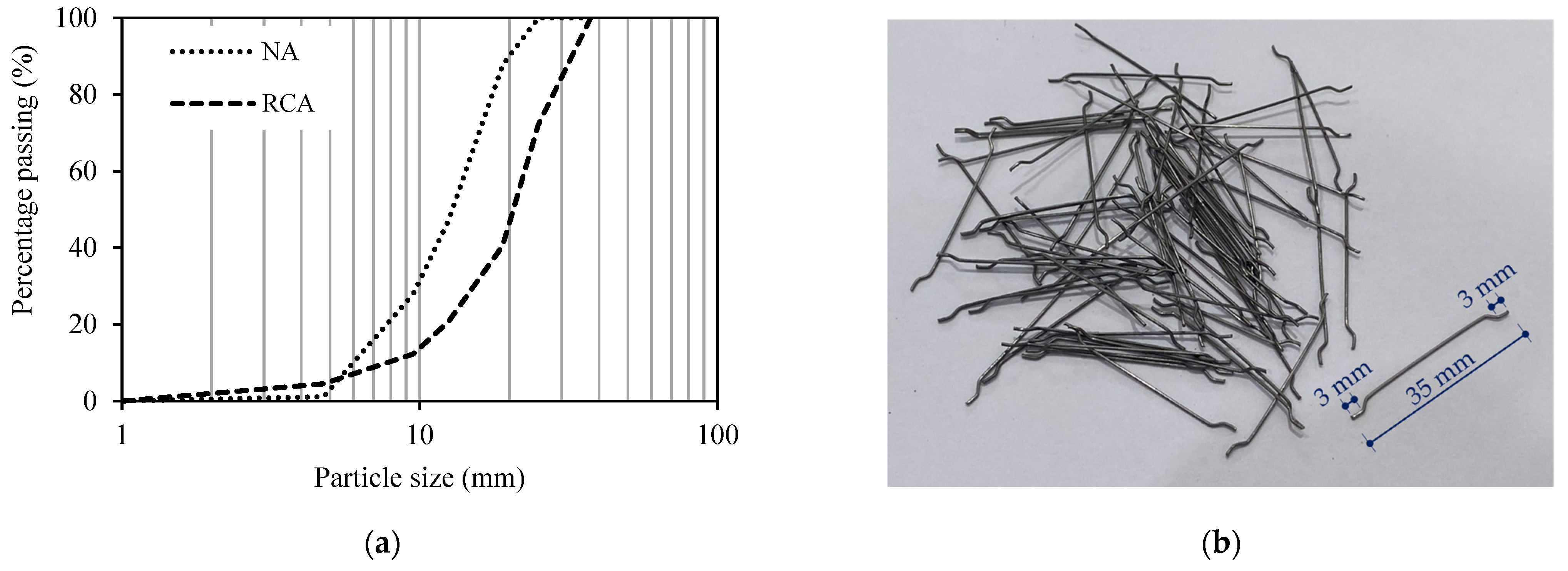

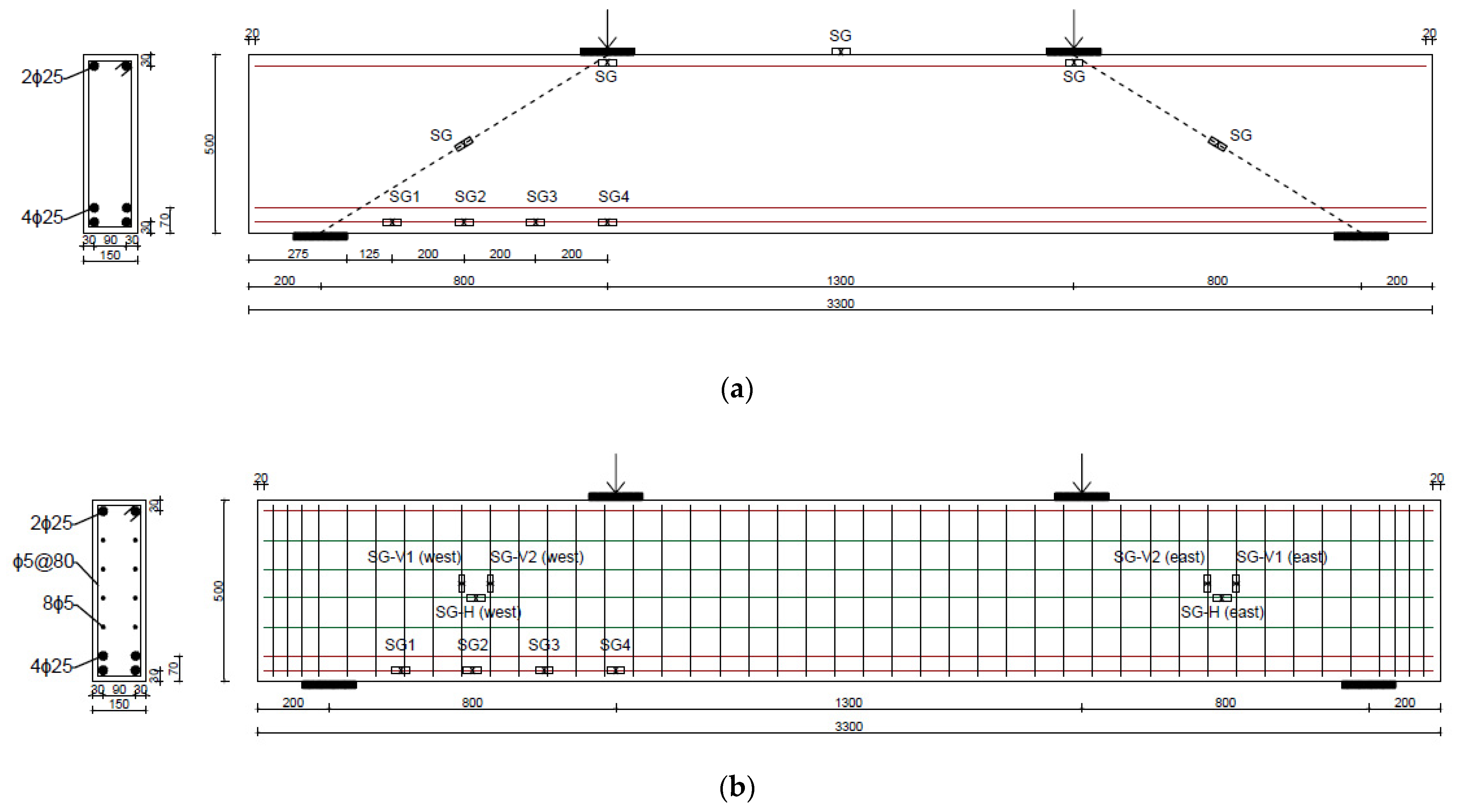
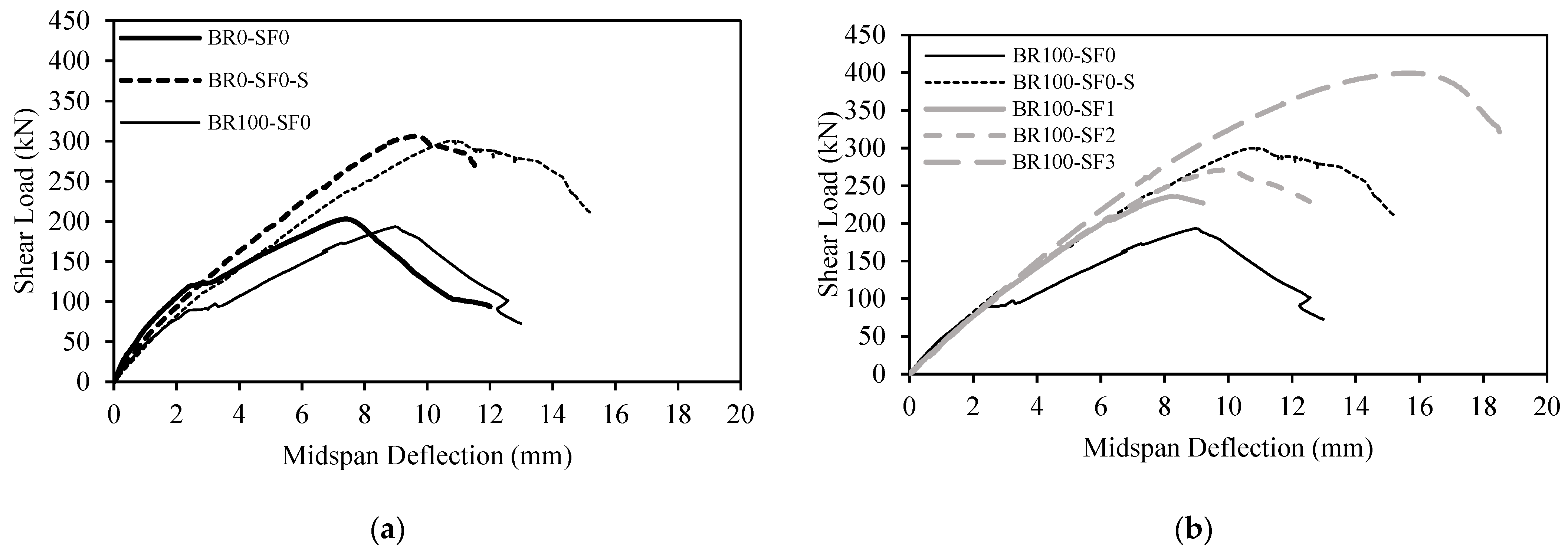
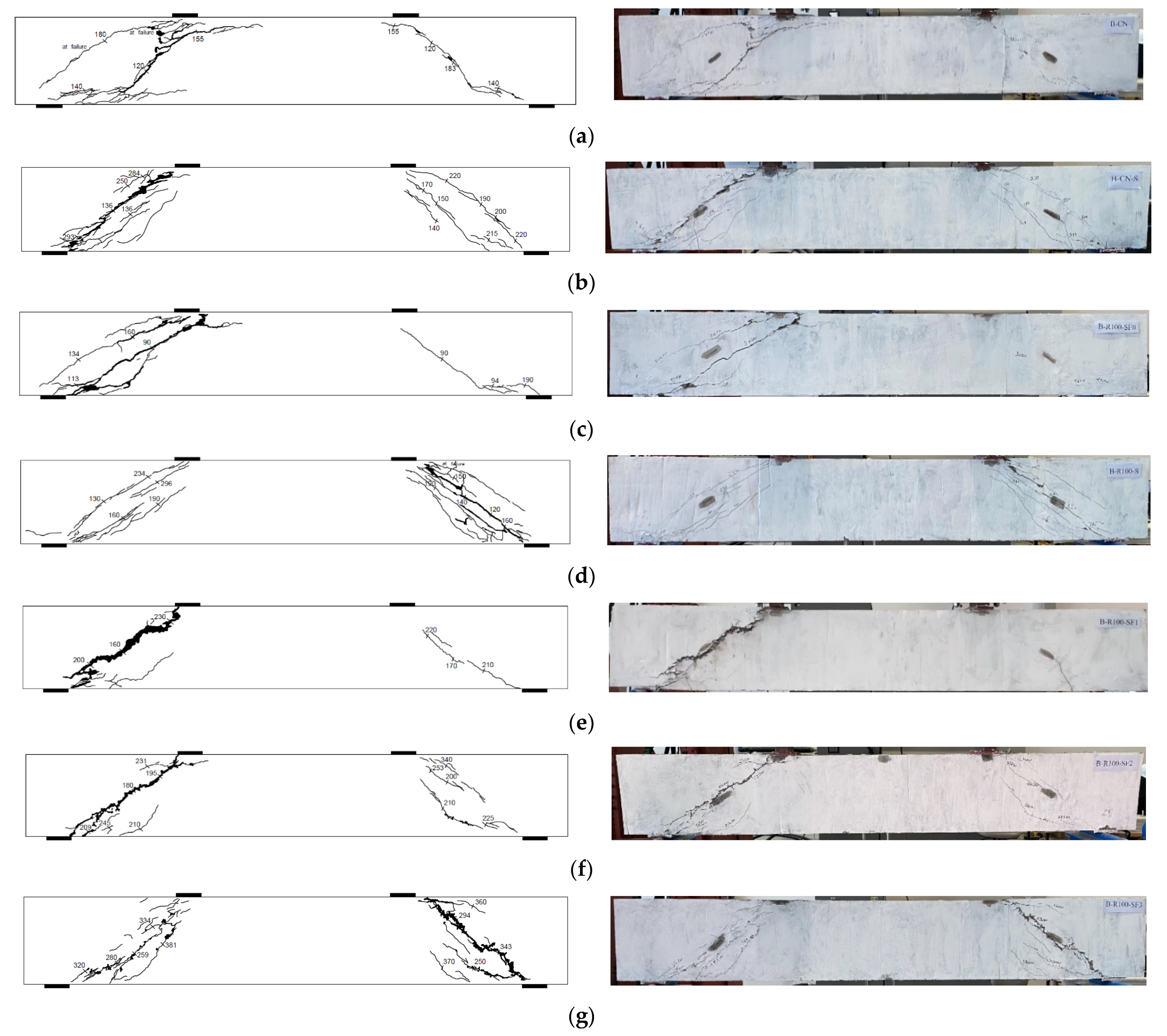
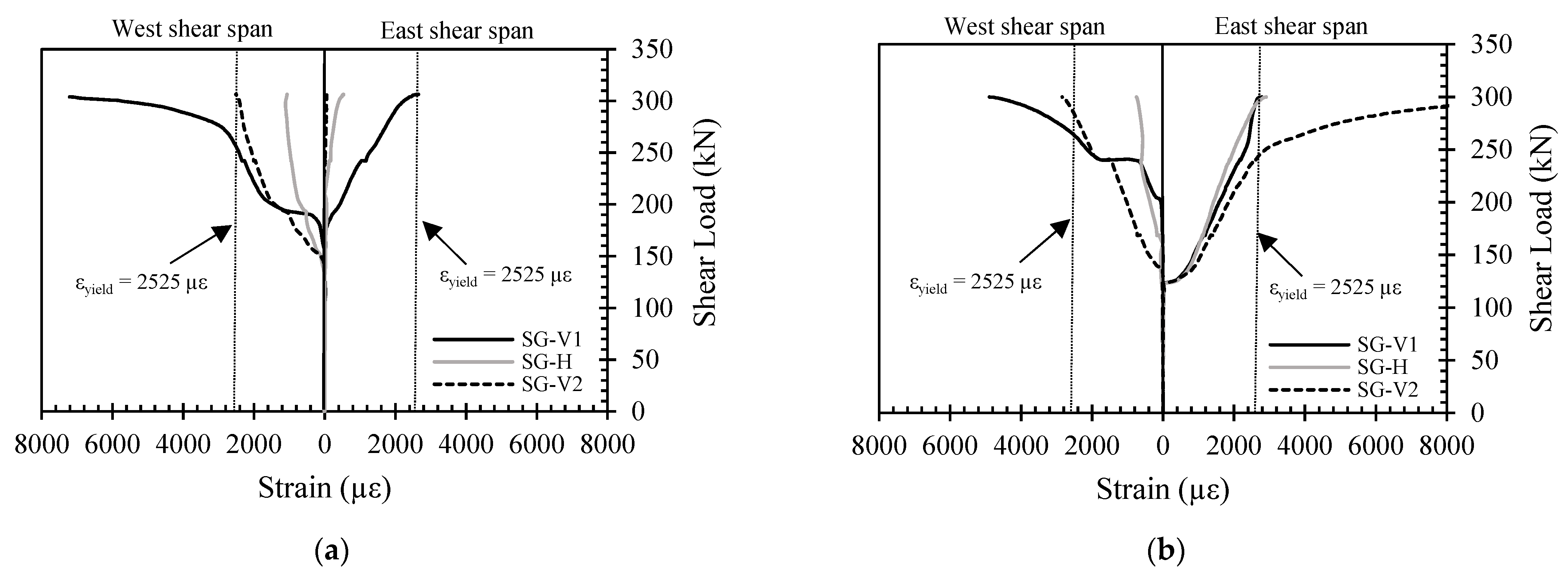
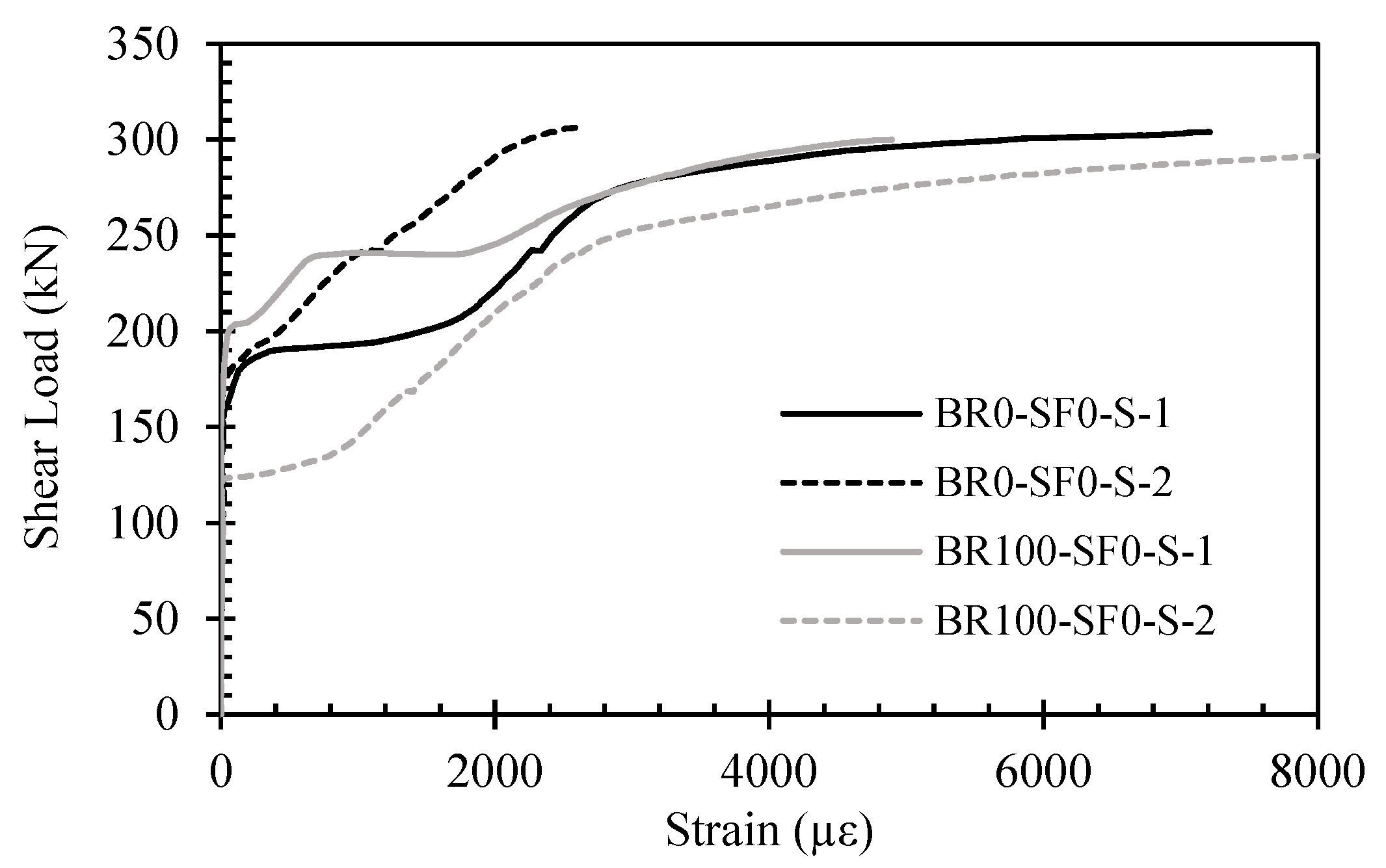

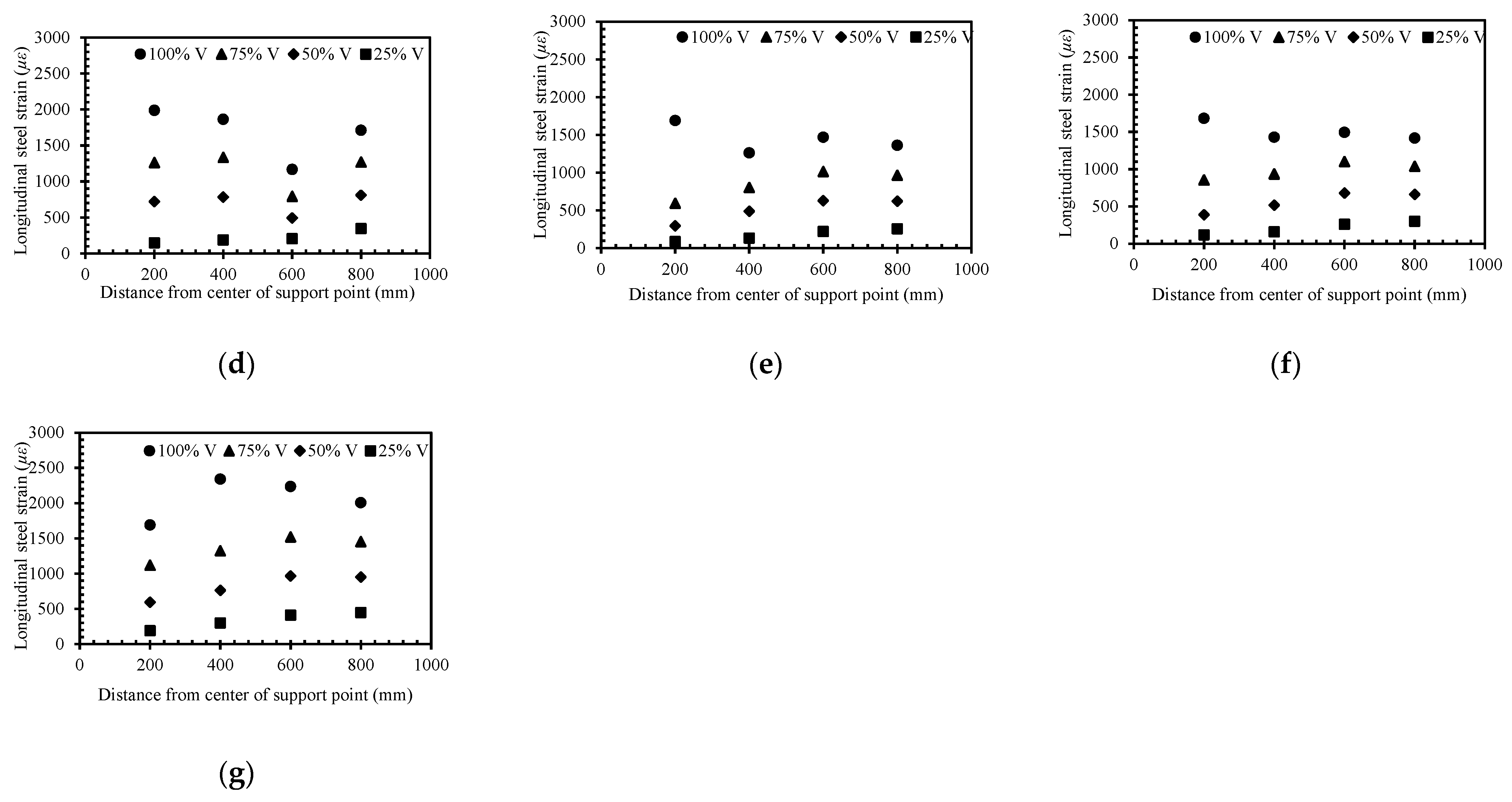
| Property | Bulk Density | Water Absorption | LA Abrasion | Surface Area | Soundness (MgSO4) | Specific Gravity | Fineness Modulus |
|---|---|---|---|---|---|---|---|
| Unit | kg/m3 | % | % | cm2/g | % | - | - |
| ASTM test | C29 | C127 | C131 | C136 | C88 | C127 | C136 |
| NA | 1635 | 0.62 | 16 | 2.49 | 1.2 | 2.82 | 6.82 |
| RCA | 1563 | 6.63 | 32.6 | 2.5 | 2.78 | 2.63 | 7.44 |
| Mixture No. | Mixture Designation | Cement | RCA | NA | Dune Sand | Water | Steel Fibers |
|---|---|---|---|---|---|---|---|
| 1 | R0-SF0 | 470 | 0 | 1130 | 570 | 230 | 0 |
| 2 | R100-SF0 | 470 | 1130 | 0 | 570 | 230 | 0 |
| 3 | R100-SF1 | 470 | 1130 | 0 | 570 | 230 | 78 |
| 4 | R100-SF2 | 470 | 1130 | 0 | 570 | 230 | 156 |
| 5 | R100-SF3 | 470 | 1130 | 0 | 570 | 230 | 234 |
| Mixture No. | Mixture Designation | Slump (mm) | f′c (MPa) | fcu (MPa) | Ec (GPa) | fsp (MPa) |
|---|---|---|---|---|---|---|
| 1 | R0-SF0 | 228 | 36.4 ± 1.5 | 40.5 ± 1.8 | 34.7 ± 1.8 | 3.1 ± 0.2 |
| 2 | R100-SF0 | 183 | 23.6 ± 0.4 | 24.7 ± 1.0 | 19.8 ± 2.4 | 2.1 ± 0.2 |
| 3 | R100-SF1 | 85 | 25.8 ± 0.3 | 32.2 ± 0.6 | 21.5 ± 2.9 | 3.1 ± 0.1 |
| 4 | R100-SF2 | 60 | 25.6 ± 1.4 | 30.0 ± 1.0 | 20.7 ± 2.5 | 3.4 ± 0.2 |
| 5 | R100-SF3 | 20 | 25.0 ± 0.8 | 28.3 ± 0.7 | 21.1 ± 1.6 | 4.1 ± 0.6 |
| Specimen Designation | RCA (%) | vf (%) | Presence of Traditional Shear Reinforcement |
|---|---|---|---|
| BR0-SF0 | - | - | - |
| BR0-SF0-S | - | - | √ |
| BR100-SF0 | 100 | - | - |
| BR100-SF0-S | 100 | - | √ |
| BR100-SF1 | 100 | 1 | - |
| BR100-SF2 | 100 | 2 | - |
| BR100-SF3 | 100 | 3 | - |
| Specimen | Shear Cracking Stage | Ultimate Stage | Vcr/Vmax | Gain in Shear Capacity * | ||
|---|---|---|---|---|---|---|
| Vcr (kN) | Δcr (mm) | Vmax (kN) | Δmax (mm) | |||
| BR0-SF0 | 120 | 2.6 | 203 | 7.2 | 0.59 | - |
| BR0-SF0-S | 136 | 3.2 | 306 | 9.7 | 0.44 | - |
| BR100-SF0 | 90 | 2.9 | 193 | 9.0 | 0.47 | - |
| BR100-SF0-S | 120 | 3.2 | 300 | 10.7 | 0.40 | 55% |
| BR100-SF1 | 160 | 4.6 | 235 | 8.2 | 0.68 | 22% |
| BR100-SF2 | 180 | 5.2 | 271 | 9.8 | 0.66 | 40% |
| BR100-SF3 | 250 | 7.1 | 400 | 15.6 | 0.63 | 107% |
| Specimen | Concrete Strain (µε) | Max. Longitudinal Steel Strain εs (µε) | εs/εy | |
|---|---|---|---|---|
| Max. Longitudinal Strain | Max. Diagonal Strain | |||
| BR0-SF0 | 2125 | 400 | 1286 | 0.48 |
| BR0-SF0-S | 1850 | 425 | 1864 | 0.69 |
| BR100-SF0 | 1400 | 730 | 2452 | 0.91 |
| BR100-SF0-S | 2090 | 815 | 1988 | 0.74 |
| BR100-SF1 | 1650 | 1150 | 1689 | 0.63 |
| BR100-SF2 | 1670 | 1130 | 1686 | 0.63 |
| BR100-SF3 | 3150 | 2280 | 2340 | 0.87 |
| Specimen | Experimental Results Vmax (kN) | Analytical Results Vn (kN) | Ratio (Vn/Vmax) | ||||
|---|---|---|---|---|---|---|---|
| Narayanan and Darwish [42] | Ashour et al. [43] | Kwak et al. [44] | Narayanan and Darwish [42] | Ashour et al. [43] | Kwak et al. [44] | ||
| BR0-SF0 | 203 | 218 | 169 | 258 | 1.07 | 0.83 | 1.27 |
| BR0-SF0-S | 306 | 305 * | 256 * | 345 | 1.00 | 0.84 | 1.13 |
| BR100-SF0 | 193 | 192 | 146 | 200 | 0.99 | 0.76 | 1.04 |
| BR100-SF0-S | 300 | 280 * | 233 * | 286 | 0.93 | 0.78 | 0.95 |
| BR100-SF1 | 235 | 275 | 230 | 287 | 1.17 | 0.98 | 1.22 |
| BR100-SF2 | 271 | 341 | 310 | 332 | 1.26 | 1.14 | 1.23 |
| BR100-SF3 | 400 | 416 | 389 | 398 | 1.04 | 0.97 | 1.00 |
| Average | 1.07 | 0.90 | 1.12 | ||||
| Std Dev | 0.11 | 0.14 | 0.13 | ||||
| COV (%) | 11 | 15 | 11 | ||||
Publisher’s Note: MDPI stays neutral with regard to jurisdictional claims in published maps and institutional affiliations. |
© 2021 by the authors. Licensee MDPI, Basel, Switzerland. This article is an open access article distributed under the terms and conditions of the Creative Commons Attribution (CC BY) license (https://creativecommons.org/licenses/by/4.0/).
Share and Cite
Kachouh, N.; El-Maaddawy, T.; El-Hassan, H.; El-Ariss, B. Shear Behavior of Steel-Fiber-Reinforced Recycled Aggregate Concrete Deep Beams. Buildings 2021, 11, 423. https://doi.org/10.3390/buildings11090423
Kachouh N, El-Maaddawy T, El-Hassan H, El-Ariss B. Shear Behavior of Steel-Fiber-Reinforced Recycled Aggregate Concrete Deep Beams. Buildings. 2021; 11(9):423. https://doi.org/10.3390/buildings11090423
Chicago/Turabian StyleKachouh, Nancy, Tamer El-Maaddawy, Hilal El-Hassan, and Bilal El-Ariss. 2021. "Shear Behavior of Steel-Fiber-Reinforced Recycled Aggregate Concrete Deep Beams" Buildings 11, no. 9: 423. https://doi.org/10.3390/buildings11090423
APA StyleKachouh, N., El-Maaddawy, T., El-Hassan, H., & El-Ariss, B. (2021). Shear Behavior of Steel-Fiber-Reinforced Recycled Aggregate Concrete Deep Beams. Buildings, 11(9), 423. https://doi.org/10.3390/buildings11090423








